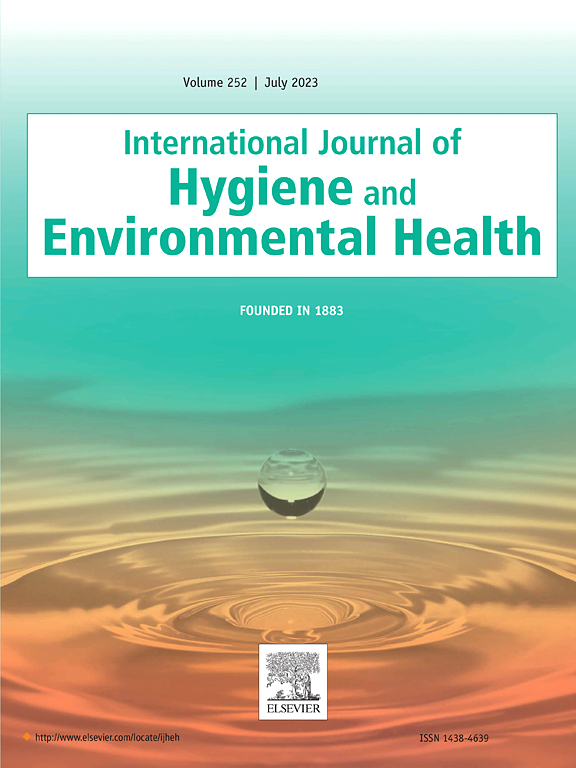A physiologically based kinetic model for quantifying human exposure to DEET
IF 4.4
2区 医学
Q1 INFECTIOUS DISEASES
International journal of hygiene and environmental health
Pub Date : 2025-06-28
DOI:10.1016/j.ijheh.2025.114616
引用次数: 0
Abstract
Background
N,N-diethyl-3-methylbenzamide (DEET) is an active ingredient of insect repellents that are applied on skin against mosquitoes and ticks. We developed a human PBK model of DEET and 3-(diethylcarbamoyl)benzoic acid (DCBA, a primary metabolite of DEET). The PBK model was used to interpret a biomonitoring study of DEET in children.
Methods
The model was built in three steps. First, systemic models of DEET and DCBA were built and linked based on in vitro and in vivo data and in silico predictions. Second, a mechanistic dermal absorption model of DEET was developed and optimized based on in vitro permeation test (IVPT) data. Finally, the systemic model was linked to the dermal model. Predictions of the integrated model were evaluated using in vivo dermal exposure study data. This model was used to interpret urine concentrations of DEET following use of DEET containing repellents by children at a summer camp.
Results
The model (i.e., combined dermal and systemic models) whose urinary predictions were within the 2-fold range was used to simulate the time-course profile of DEET; results were compared against data from a previously published pharmacokinetic study. The estimated typical amount of applied DEET at the summer camp over 24 h was 69.0 mg with a predicted dermal bioavailability of 24.2 %.
Conclusion
A PBK model of DEET and DCBA was developed and validated in humans by integrating publicly available data. The external dose of DEET was estimated using the PBK model, and the calculated margin of exposure is above the level of concern.

定量人体接触避蚊胺的生理动力学模型
n, n -二乙基-3-甲基苄胺(DEET)是一种有效的驱蚊剂,用于皮肤上防止蚊子和蜱虫。我们建立了避蚊胺和3-(二乙基氨基甲酰)苯甲酸(DCBA,避蚊胺的主要代谢物)的人PBK模型。PBK模型用于解释儿童避蚊胺的生物监测研究。方法分三步建立模型。首先,基于体外和体内数据以及计算机预测,建立并连接避蚊胺和DCBA的系统模型。其次,基于体外渗透试验(IVPT)数据,建立并优化避蚊胺皮肤吸收机理模型。最后,将系统模型与皮肤模型联系起来。综合模型的预测使用体内皮肤暴露研究数据进行评估。该模型用于解释夏令营儿童使用含有避蚊胺的驱蚊剂后尿液中的避蚊胺浓度。结果采用尿路预测值在2倍范围内的模型(即真皮和全身联合模型)模拟避蚊胺的时间过程;结果与先前发表的药代动力学研究的数据进行了比较。估计夏令营24小时内避蚊胺的典型施用量为69.0 mg,预测皮肤生物利用度为24.2%。结论通过整合公开数据,建立了避蚊胺和DCBA的PBK模型,并在人体中进行了验证。使用PBK模型估计避蚊胺的外剂量,计算出的暴露余量高于关注水平。
本文章由计算机程序翻译,如有差异,请以英文原文为准。
求助全文
约1分钟内获得全文
求助全文
来源期刊
CiteScore
11.50
自引率
5.00%
发文量
151
审稿时长
22 days
期刊介绍:
The International Journal of Hygiene and Environmental Health serves as a multidisciplinary forum for original reports on exposure assessment and the reactions to and consequences of human exposure to the biological, chemical, and physical environment. Research reports, short communications, reviews, scientific comments, technical notes, and editorials will be peer-reviewed before acceptance for publication. Priority will be given to articles on epidemiological aspects of environmental toxicology, health risk assessments, susceptible (sub) populations, sanitation and clean water, human biomonitoring, environmental medicine, and public health aspects of exposure-related outcomes.

 求助内容:
求助内容: 应助结果提醒方式:
应助结果提醒方式:


